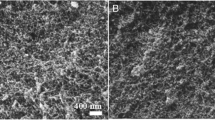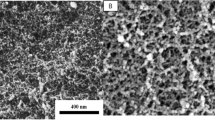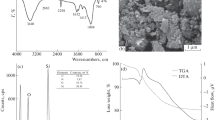Abstract
In this study, three silicalite adsorbents (silicalite a, silicalite b and silicalite c) for ethanol adsorption from aqueous phase were synthesized using tetraethylorthosilicate, Ludax solution and a new organic silica source, Tabasheer, respectively. Tetrapropylammonium hydroxide was used as primary structure directing agent and starch as secondary structure directing agent. XRD, BET, FT-IR and FE-SEM were used to characterize synthesized adsorbents. Single component adsorption for ethanol and water was investigated by non-adsorbing solvent concept. Binary adsorption isotherms of both components were also experimentally measured. A model based on real adsorbed solution theory was developed to predict experimental adsorption data. The XRD characterization confirmed that all silicalite adsorbents have the same MFI-type structure. FE-SEM results revealed that the different silica sources have impact on surface area and morphology. The BET surface area for adsorbents is in order of silicalite c > silicalite a > silicalite b. However, uptake rate toward ethanol is in order of silicalite a > silicalite c > silicalite b. The model based on real adsorbed solution theory predicted experimental adsorption isotherm data very well. In addition, results revealed that the binary adsorption uptake is lower than single component adsorption.













Similar content being viewed by others
Abbreviations
- Aij :
-
Adjustable parameter of NRTL model
- Ce :
-
Equilibrium concentration (g/gsol)
- \({C_{i,0}}\) :
-
Initial concentration of component i in the mixture
- \({C_{i,e}}\) :
-
Equilibrium concentrations of component i in the liquid mixture contacting the adsorbent.
- Ci :
-
Concentration of solute i at equilibrium in bulk phase liquid
- \(C_{i}^{0}\) :
-
Equilibrium single-solute ith adsorbed at the same temperature and spreading pressure of the system
- K:
-
Langmuir isotherm constant (gsol/g)
- \({m_{Ad}}\) :
-
Total mass adsorbed
- \({m_{l,0}}\) :
-
Mass of initial liquid solution added to the flask
- \({m_{l,R}}\) :
-
Mass of liquid mixture that removed after equilibrium
- \({m_l}\) :
-
Mass of remaining liquid in contact with adsorbent after \({m_{l,R}}\) liquid is removed
- mso :
-
Initial mass of solute added to the sample
- msv :
-
Mass of isooctane added to sample
- mAds :
-
Mass of adsorbent added to the vial.
- N:
-
Number of data point
- \({n_i}\) :
-
Adsorbed amount of each component
- \(n_{i}^{o}\) :
-
Total number of pure component i adsorbed at the same spreading pressure and temperature of mixture
- \({q_A}\) :
-
Amount of adsorbate A adsorbed into the adsorbent (g/gads)
- \({q_{ads}}\) :
-
Amount of solute adsorbed
- \(q_{i}^{0}\) :
-
Single component adsorption isotherm equation
- \({q_{i,\exp }}\) :
-
Value of experimental data point
- \({q_{i,calc}}\) :
-
Value of model prediction
- \({q_m}\) :
-
Maximum adsorption loading (g/gads)
- Va :
-
Adsorbent volume
- Vl :
-
Liquid mixture volume
- Vt :
-
Total volume of the flask
- \({w_{l,Et}}\) :
-
Ethanol mass fraction in bulk liquid phase
- \({w_{l,wt}}\) :
-
Water mass fraction in bulk liquid phase
- \({w_{a,wt}}\) :
-
Water mass fraction in adsorbed phase
- \({w_{a,Et}}\) :
-
Ethanol mass fraction in adsorbed phase
- w0 :
-
Initial total mass of liquid mixture (g)
- W s :
-
Mass of adsorbent (g)
- \({x_b}\) :
-
Weight fraction of solute in blank sample
- xi :
-
Equilibrium liquid mole fraction of component i
- xi0 :
-
Initial liquid mole fraction of component i
- \({x_{si}}\) :
-
Weight fraction of solute in adsorbent sample vial
- zi :
-
Mole fraction of species i adsorbed inside solid pores
- α:
-
Separation factor on mass basis
- αij :
-
Adjustable parameter of NRTL model
- π:
-
Spreading pressure
- Γi :
-
Surface excess (mole/g)
- \(\gamma _{i}^{L}\) :
-
Activity coefficient of species i in bulk phase at system temperature
- \(\gamma _{i}^{{Ls}}\) :
-
Activity coefficient of species i in fluid inside solid pores
- \(\mu _{i}^{L}\) :
-
Chemical potential of species i in bulk liquid phase
- \(\mu _{i}^{{Ls}}\) :
-
Chemical potential in liquids inside the solid pores.
- \({\rho _a}\) :
-
Density of the adsorbent (g/cm3)
- \({\rho _l}\) :
-
Density of the liquid (g/cm3)
References
Abdehagh, N., Tezel, F.H., Thibault, J.: Adsorbent screening for biobutanol separation by adsorption: kinetics, isotherms and competitive effect of other compounds. Adsorption. 19, 1263–1272 (2013). https://doi.org/10.1007/s10450-013-9566-8
Adnacrossed, D., Signević, B., Mojović, Z., Abu Rabi, A.: The kinetics of ethanol adsorption from the aqueous phase onto zeolite NaZSM-5. Adsorption. 14, 123–131 (2008). https://doi.org/10.1007/s10450-007-9077-6
Adnadevic, B., Mojovic, Z., Rabi, A.A., Jovanovic, J.: Isoconversional kinetic analysis of isothermal selective ethanol adsorption on zeolite type NaZSM-5. Chem. Eng. Technol. 30, 1228–1234 (2007). https://doi.org/10.1002/ceat.200700147
Bartholdy, S., Bjørner, M.G., Solbraa, E., Shapiro, A., Kontogeorgis, G.M.: Capabilities and limitations of predictive engineering theories for multicomponent adsorption. Ind. Eng. Chem. Res. 52, 11552–11563 (2013). https://doi.org/10.1021/ie400593b
Bastidas, P.A., Gil, I.D., Rodriguez, G.: Comparison of the main ethanol dehydration technologies through process simulation. In: 20th Eurpean Symp. Comput. aided Process Eng.—ESCAPE20, pp. 1–6: (2010)
Bono, A., Yadin, N., Ramlan, N., Yan, F.Y., Ming, C.C.: Liquid phase adsorption of multi-component organic solvent mixture onto activated carbon. Int J Chem Environ Sci 1, 520–523 (2013)
Bowen, T.C., Vane, L.M.: Ethanol, acetic acid, and water adsorption from binary and ternary liquid mixtures on high-silica zeolites. Langmuir. 22, 3721–3727 (2006). https://doi.org/10.1021/la052538u
Chempath, S., Denayer, J.F.M., De Meyer, K.M.A., Baron, G.V., Snurr, R.Q.: Adsorption of liquid-phase alkane mixtures in silicalite: simulations and experiment. Langmuir. 20, 150–156 (2004). https://doi.org/10.1021/la035362&%23x002B;
Dabrowski, A., Jaroniec, M.: Excess adsorption isotherms for solid-liquid systems and their analysis to determine the surface phase capacity. Adv. Colloid Interface Sci. 31, 155–223 (1990). https://doi.org/10.1016/0001-8686(90)80006-L
Dawoud, B., Amer, E., Gross, D.: Experimental investigation of an adsorptive thermal energy storage. Int. J. Energy Res. 31, 135–147 (2007). https://doi.org/10.1002/er.1235
Erto, A., Lancia, A., Musmarra, D.: A modelling analysis of PCE/TCE mixture adsorption based on Ideal adsorbed solution theory. Sep. Purif. Technol. 80, 140–147 (2011). https://doi.org/10.1016/j.seppur.2011.04.021
Erto, A., Lancia, A., Musmarra, D.: A real adsorbed solution theory model for competitive multicomponent liquid adsorption onto granular activated carbon. Microporous Mesoporous Mater. 154, 45–50 (2012). https://doi.org/10.1016/j.micromeso.2011.10.041
Falamaki, B.C., Sohrabi, M., Talebi, G.: The kinetics and equilibrium of ethanol adsorption from aqueous phase using calcined (Na-1, 6-Hexanediol) -ZSM-5. Chem. Eng. Technol. 24, 501–506 (2001). https://doi.org/10.1002/1521-4125
Farhadpour, F.A., Bono, A.: Adsorption from solution of nonelectrolytes by microporous crystalline solids: ethanol-water/silicalite system. J. Colloid Interface Sci. 124, 209–227 (1988). https://doi.org/10.1016/0021-9797(88)90341-4
Ge, T., Hua, Z., He, X., Zhu, Y., Ren, W., Chen, L., Zhang, L., Chen, H., Lin, C., Yao, H., Shi, J.: One-pot synthesis of hierarchically structured ZSM-5 zeolites using single micropore-template. Cuihua Xuebao/Chine. J. Catal. 36, 866–873 (2015). https://doi.org/10.1016/S1872-2067(14)60263-1
Huang, H.J., Ramaswamy, S., Tschirner, U.W., Ramarao, B.V.: A review of separation technologies in current and future biorefineries. Sep. Purif. Technol. 62, 1–21 (2008). https://doi.org/10.1016/j.seppur.2007.12.011
Jadhav, A.J., Srivastava, V.C.: Adsorbed solution theory based modeling of binary adsorption of nitrobenzene, aniline and phenol onto granulated activated carbon. Chem. Eng. J. 229, 450–459 (2013). https://doi.org/10.1016/j.cej.2013.06.021
Kida, T., Kojima, K., Ohnishi, H., Guan, G., Yoshida, A.: Synthesis of large silicalite-1 single crystals from two different silica sources. Ceram. Int. 30, 727–732 (2004). https://doi.org/10.1016/j.ceramint.2003.08.011
Liu, J.-Y., Wang, J.-G., Li, N., Zhao, H., Zhou, H.-J., Sun, P.-C., Chen, T.-H.: Polyelectrolyte–surfactant complex as a template for the synthesis of zeolites with intracrystalline mesopores. Langmuir. 28, 8600–8607 (2012). https://doi.org/10.1021/la300447n
Malik, R.K., Ghosh, P., Ghose, T.K.: Ethanol separation by adsorption-desorption. Biotechnol. Bioeng. 25, 2277–2282 (1983). https://doi.org/10.1002/bit.260250913
Milestone, N.B., Bibby, D.M.: Concentration of alcohols by adsorption on silicalite. J. Chem. Technol. Biotechnol. 31, 732–736 (2007). https://doi.org/10.1002/jctb.503310198
Mohamed, M.M., Zidan, F.I., Thabet, M.: Synthesis of ZSM-5 zeolite from rice husk ash: characterization and implications for photocatalytic degradation catalysts. Microporous Mesoporous Mater. 108, 193–203 (2008). https://doi.org/10.1016/j.micromeso.2007.03.043
Onuki, S., Koziel, J., Jenks, J.V.L., Grewell, W.S., Cai, D.: L.: Ethanol production, purification, and analysis techniques: a review. ASABE Annu. Int. Meet. 0300, 11 (2008)
Panpa, W., Jinawath, S.: Synthesis of ZSM-5 zeolite and silicalite from rice husk ash. Appl. Catal. B Environ. 90, 389–394 (2009). https://doi.org/10.1016/j.apcatb.2009.03.029
Pengthamkeerati;, P., Kraewong;, W., Meesukd, L.: Green synthesis of nano-silicalite-1: biomass fly ash as a silica source and mother liquid recycling. Environ. Prog. 28, 404–409 (2009). https://doi.org/10.1002/ep.11940
Sánchez-Flores, N.A., Solache, M., Olguín, M.T., Legaspe, J., Pacheco-Malagón, G., Saniger, J.M., Martinez, E., Bulbulian, S., Fripiat, J.J.: Silicalite-1, an adsorbent for 2-, 3-, and 4-chlorophenols. Water Sci. Technol. 66, 247–253 (2012). https://doi.org/10.2166/wst.2012.073
Scott, G., Thompson, R.W., Dixon, A.G., Sacco, A.: The role of triethanolamine in zeolite crystallization. Zeolites. 10, 44–50 (1990). https://doi.org/10.1016/0144-2449(90)90093-7
Tao, H., Li, C., Ren, J., Wang, Y., Lu, G.: Synthesis of mesoporous zeolite single crystals with cheap porogens. J. Solid State Chem. 184, 1820–1827 (2011). https://doi.org/10.1016/j.jssc.2011.05.023
Vakili, D., Attarnejad, M.A., Massoodian, S.K., Akbarnejad, M.M.: Synthesis of hydrophobic silicalite adsorbent from domestic resources: the effect of alkalinity on the crystal size and morphology. Iran. J. Chem. Chem. Eng. 24, 9–14 (2005)
Yu, M., Falconer, J.L., Noble, R.D.: Adsorption of liquid mixtures on silicalite-1 zeolite: a density-bottle method. Langmuir. 21, 7390–7397 (2005). https://doi.org/10.1021/la050856n
Zhang, M., Liu, X., Yan, Z.: Soluble starch as in-situ template to synthesize ZSM-5 zeolite with intracrystal mesopores. Mater. Lett. 164, 543–546 (2016). https://doi.org/10.1016/j.matlet.2015.10.044
Zhou, H., Mouzon, J., Farzaneh, A., Antzutkin, O.N., Grahn, M., Hedlund, J.: Colloidal defect-free silicalite-1 single crystals: preparation, structure characterization, adsorption, and separation properties for alcohol/water mixtures. Langmuir. 31, 8488–8494 (2015). https://doi.org/10.1021/acs.langmuir.5b02520
Author information
Authors and Affiliations
Corresponding author
Rights and permissions
About this article
Cite this article
Hajilari, M., Shariati, A. & Khosravi-Nikou, M. Equilibrium adsorption of bioethanol from aqueous solution by synthesized silicalite adsorbents: experimental and modeling. Adsorption 25, 13–31 (2019). https://doi.org/10.1007/s10450-018-9992-8
Received:
Revised:
Accepted:
Published:
Issue Date:
DOI: https://doi.org/10.1007/s10450-018-9992-8




